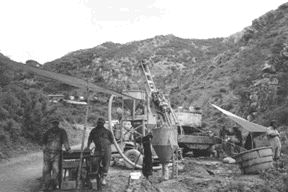A Canadian industrial holdings group has joined the joint venture consisting of Canadian-Australian junior
All four parties have signed a memorandum of understanding to evaluate the feasibility of building, owning and operating a plant with down-stream solvent extraction-electrowinning (SX-EW).
The proposed plant would produce London Metal Exchange Grade-A copper cathode and other associated base and precious metals using bioleaching technology proprietary to BacTech and Mintek.
In short, the partners want to prove that their bioleaching technology is a viable alternative to the traditional concentrate treatment processes of smelting, roasting and pressure-oxidation.
During 2001-02, the three original partners built and operated a demonstration plant in Monterrey, Mexico. On a daily basis, the facility produced 2.2 tonnes of concentrate from four sources (including material from three of Peoles’ existing mines), yielding 400 kg per day of LME Grade-A copper cathode (T.N.M., July 16/01).
The partners then completed a prefeasibility study into the viability of building a commercial plant in Mexico. The study concluded that locating a commercial plant at any one of the four mines that provided feedstock to the demonstration plant “would have its viability adversely effected by high utility costs and the compulsory employee-participation levy of 10% of net profits before tax.”
As a result, the partners added Canada to their list of possible countries in which to build the plant, citing the country’s “significantly cheaper utility costs, lower overall tax rates, investment by the industrial holdings group, government capital grants, and other financial incentives.”
The feasibility study will proceed in two phases. The first, which will apply local economic factors to the existing prefeasibility study, is due for completion by the end of the year.
Depending on the outcome of the first phase, the partners will seek out initial sources of concentrate feedstock, shorten the list of potential sites, and complete a conceptual plant design.
As well, the partners intend to conduct further technical work to determine the total capital and operating costs of copper production and undertake a study to identify other sources of feedstocks.
In May, BacTech proposed a $1.5-million private placement of units priced at 50 per unit, with each unit consisting of a common share and half a warrant. A whole warrant would allow the holder to buy another share for 80 within a year of closing. (In early October, BacTech traded around the 50 mark.)
Also in May, BacTech reached an agreement with Rothschild’s Golden Arrow Fund to extend the maturity date of the latter’s convertible note by 11 months. The $1-million note, which is now due March 31, 2003, continues to be convertible into 1.7 million BacTech shares at 60 apiece.
The original notes were exercisable at $1.10 and had an expiry date of April 30, 2002. None was exercised.
In return for the extension, BacTech issued Golden Arrow 754,717 new warrants exercisable at 80 until March 31, 2003.
Last September, BacTech and Mintek commissioned the Laizhou gold bioleaching facility in China’s Shandong province.
The plant has an initial annual capacity of 65,000 oz. gold, treating refractory gold concentrates from mines in the region. The companies reported that gold recoveries following cyanidation of the bacterial oxidation residue were running in excess of 97% using the current stockpiled concentrate feedstock. They say the high gold recovery is being achieved with modest reagent consumption of a maximum of 9 kg of cyanide per tonne and a maximum of 14 kg of lime per tonne.


Be the first to comment on "Partners pursue copper bioleaching project"